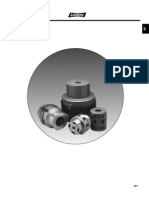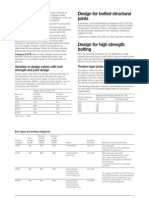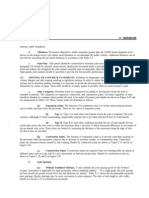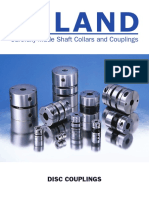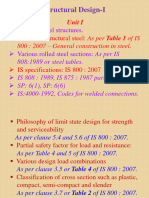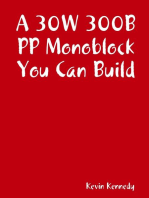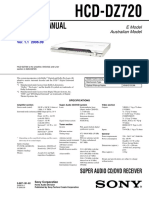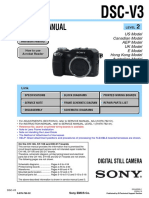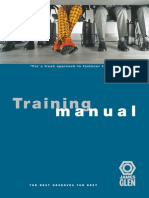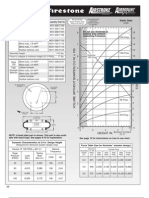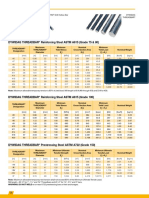INSTRUCCIONES LAMIDISC English 1001-I (Reva)
INSTRUCCIONES LAMIDISC English 1001-I (Reva)
Uploaded by
tm5u2rCopyright:
Available Formats
INSTRUCCIONES LAMIDISC English 1001-I (Reva)
INSTRUCCIONES LAMIDISC English 1001-I (Reva)
Uploaded by
tm5u2rOriginal Title
Copyright
Available Formats
Share this document
Did you find this document useful?
Is this content inappropriate?
Copyright:
Available Formats
INSTRUCCIONES LAMIDISC English 1001-I (Reva)
INSTRUCCIONES LAMIDISC English 1001-I (Reva)
Uploaded by
tm5u2rCopyright:
Available Formats
1610-M
Nº 1001 I
ISO 9001
®
All steel disc
ACCREDITED BY
coupling
CERTIFICATED FIRM
Lamidisc ®
Installation, alignment and
maintenance instructions.
Modificaciones Técnicas Reservadas
Technical modifications reserved
®
Installation of hubs . Machinery alignment.
Installation of disc packs and spacer.
1.- Installation of the hubs on the machine shafts.
a) Straight shafts with keyway.
Jaure supplies Lamidisc hubs machined machined with H7 (ISO-286) tolerances. Jaure recommends that the shaft should be machined for
an interference fit, using tolerance s6 (ISO-286).
Whenever the shafts are already machined with a different tolerance from s6, Jaure will customize the hub bores. The following tolerances
are recommended by Jaure.
Shaft tolerance Hub tolerance b) Clamping devices.
h6 T7 When clamping devices, such as tapered bushings, are used, Jaure recommends that the shafts
k6 R7 should be machined with g6 tolerances, for a standard Lamidisc bore.
m6 P7 For other type of connections, please consult our Technical Department.
n6 N7
p6 M7 2.- Machinery Alignment.
As long as the machines are aligned within the specifications from this catalog, the Lamidisc cou-
plings will operate for a long time. However, it should be understood that the useful life of any disc pack coupling is directly influenced by the
operating misalignment: the better the alignment, the longer the coupling life.
Although the Lamidisc couplings can operate satisfactorily at the misalignment listed in the catalog, both the coupling life and machine bear-
ing wear can be greatly improved if the machines are aligned better than the maximum that the coupling can accomodate. Jaure recommends
that the installation misalignment should not exceed 20 % of the catalog values. Therefore, the following formulas show Jaure´s recommen-
dations for maximum misalignment.
Three types of machine misalignment (offset, angular, and axial) should be checked. Jaure has the following recommendations:
• The maximum offset misalignment that the Lamidisc coupling can accomodate is a function of the distance between the disc packs. For the
configurations SX this distance is practically the same as the distance between the shaft ends. This statement is not valid for other configu-
rations, such as CC, DO, CX, DX.
If shafts have an offset misalignment with minimum angular misalignment, the following maximum values for the offset are applicable for
installation.
Lamidisc® with 6 bolts TIR = ( disc pack to disc pack distance ) / 150
Lamidisc® with 8 bolts TIR = ( disc pack to disc pack distance ) / 300
Lamidisc® with 10 bolts TIR = ( disc pack to disc pack distance ) / 350
(NOTE : TIR is the Total Indicator Reading, which is twice the shaft offset)
Ex.: For size 380-6, SX type: TIR < DBSE/150.
• The maximum angular misalignment at each disc pack during installation is listed in the tables. This angular misalignment can be verified by meas-
uring the flange-to-flange distance (see figure below) and substracting the smallest reading from the largest reading (Y-Z). The maximum value of (Y-
Z) depends on the flange diameter, therefore on the coupling size. Based on the data from the tables, the following maximum values for (Y-Z) are rec-
ommended:
Lamidisc with 6 bolts (Y-Z) = Coupling size / 300
Lamidisc with 8 bolts (Y-Z) = Coupling size / 600
Lamidisc with 10 bolts (Y-Z) = Coupling size / 750
Example: For Lamidisc size 380-6 ( maximum angular
misalignment of 1º). (Y-Z) should not exceed
380/300 = 1.27 mm. during installation.
• The axial displacement allowable between shafts dur-
ing installation (∆x), should not exceed 20% of the allow-
able displacement given in the catalog (∆ka) (See table
1). This displacement is a function of the coupling size
and the number of bolts utilized. The larger the size the
larger axial displacement.
The axial displacement creates large stresses in the
discs. For a long life it is recommended that the discs
are as close as possible to being flat. Therefore, the
movements of the shafts as caused by thermal expan-
sion should be carefully considered. For instance, if the
distance between shaft ends changes by 5 mm (the
shafts are coming closer to each others) from cold to hot machines, the distance between shaft ends with cold machines should be intentionally be made
larger by 5 mm when the coupling is installed.
Table 1. Allowable installation axial displacement (20% of catalog valves, ∆x=0.2∆ka).
This value can be added or subtracted from the nominal DBSE. Values for 2 disc packs.
(±) ∆x installation (mm.)
6 Bolts OD/250
8 Bolts OD/375
10 Bolts OD/500
Coupling OD in (mm.)
Example: Size 228-6:±∆ka = 228/250 = ±0.9 mm, for 2 disc packs during installation.
3.- Installation of disc packs and spacer.
The installation of the coupling components depends of the type Lamidisc coupling: the only tool needed are regular wrenches or sockets, and
a torque wrench. Tightening the bolts of a coupling to specification is very important.
a) Standard configuration. SX and SXR types.
The only bolts to be installed and tightened are the ones that attach the disc packs to the hubs and spacer. Place the spacer and install the
bolts with their heads at the flange and not at the disc pack. The nuts shall be turned with the torque wrench, while the heads of the bolts are
held stationary.
Technical modifications reserved
page 2
®
Table 2. Bolt tightening torque values. Values for spacer (type CX) and flange (type DX) bolt non
In case an specific exists, refer to the values mentioned in it if they differ lubricated tigthening torque in Nm.
from the values below.
Values for Disc bolt tightening torque:
Size Disc bolt Size Disc bolt Size Disc bolt Size CX and Size CX and
non-lubricated non-lubricated non-lubricated DX types DX types
tightening tightening tightening 132-6/10 8 302-8/40 230
torque (Nm) torque (Nm) torque (Nm) 158-6/15 20 325-8/45 230
110 30 302 600 540 4100 185-6/20 68 345-8/50 325
132 30 325 600 570 5100 202-6/25 108 380-8/55 325
158 60 345 780 605 6200 255-6/30 108 410-8/60 325
185 100 380 1100 635 7900 278-8/35 230 540-8/70 565
202 150 410 1500 675 9900
228 230 440 2000 700 12200
255 450 475 2600 730 12200
278 450 505 3300 760 14800
NOTE: For lubricated threads reduce the given values by 20%.
For stainless-steel bolts refer to our technical Dep.
Values for dry tightening torque in Nm for flange connecting bolts. Table 3. l1, l2 and s catalog valves for CC, CCR
Types DO-6 and DO-8. types.
Size Bolt Size Bolt Size Bolt Size Bolt Size l1 - l2 s Size l1 - l2 s
tigthening tigthening tigthening tigthening 110 50 8.4 302 135 24.4
torque (Nm) torque (Nm) torque (Nm) torque (Nm) 132 60 8.4 325 145 26
110-6 35 302-6 780 278-8 108 475-8 660 158 70 11.2 345 155 28.2
132-6 35 325-6 780 302-8 108 505-8 660 185 80 14.0 380 170 32
158-6 69 345-6 580 325-8 325 540-8 760 202 90 15.5 410 185 33.2
185-6 120 380-6 780 345-8 325 570-8 760 228 100 17.5 440 195 36.4
202-6 190 410-6 1000 380-8 325 605-8 760 255 115 20.5 475 210 38.2
228-6 295 440-6 1500 410-8 565 278 125 21.2 505 230 42
255-6 580 475-6 2000
278-6 580 505-6 2000
NOTE: For lubricated threads reduce the given values by 20%.
For stainless-steel bolts refer to our technical Dep.
b) Close coupled configuration. CC and CCR types.
The CC coupling type was created for use with machines that have the shafts too close for the use of the standard SX coupling. The outside
diameter of the hubs was reduced to be inserted in the inside of the hole of the disc pack.
To install the hubs on their shafts, the shafts must be spaced apart at least the length of one hub (see dimension l1 and l2 in table 3). To install
the coupling, the disc packs can be first attached with their bolts to the spacer, and then slid over one of the hubs, and attached to it. Next, the
machines must be brought in position so that the second disc pack can be attached to its hub.
The machine alignment can now be performed. Because the spacer covers the shaft ends, the axial spacing must be checked by measuring
the flange to flange distance (dimension “S” in the table 3). The offset and angular misalignments can be checked as previously described.
The bolts that attach the disc packs to the hubs and spacer must be tighten to specification, using a torque wrench at the nuts, while the bolts
heads are held stationary.
c) Drop-out configuratio . DO type. (See table 4 in page 4).
The drop-out configuration allows the installation and removal of the coupling assembly , without the need to remove the hubs from their
shafts. The coupling is received from Jaure fully assembled, with the bolts tightened to specifications. If, however, there is a need to disas-
semble the coupling assembly in case the disc packs need to be replaced ) the nuts should be tightened to Jaure’s specification (valves not
shown in these instructions) using a torque wrench, while the bolt heads are held stationary.
The coupling assembly will not fit between the hubs, as long as the shaft-to-shaft distance was correctly set. The coupling ends should be
brought together, by compressing the disc packs using the flange screws in the shipping holes, so that the assembly will fit between the male
rabbets.
Once in position, the coupling will snap in place, and the bolts that attach the assembly to the shaft hubs must be tightened to Jaure specifi-
cations (see table 2) using a torque wrench. This operation must be carefully performed, as these bolts transmit the full coupling torque.
Machine alignment should be done before the coupling assembly is in place.
To remove the coupling assembly first remove all the bolts that retain it to the shaft hubs. Then compress the assembly by introducing the
existing flange bolts in the shipping holes, and press the coupling assembly away from the male rabbets.
d) Reduced moment coupling with spacer according to AGMA 516, CX type.
The reduced moment configuration is used whenever the shaft stresses require that the center of gravity of the coupling is very close to the
machine bearings. This configuration also allows either machine to be removed by dropping the spacer, without the need to disturb the disc-
pack assemblies.
The installation of this coupling requires the following steps:
- Install the hubs on their shafts.
- Measure and adjust the shaft to shaft (DBSE) distance.
- Align the machine shafts as previously described.
- Attach one disc pack and a short sleeve at each hub, by tightening the nuts to specifications, while holding the bolt heads stationary.
- Place the spacer between the two sleeves. It should fit without interference, or without a gap remaining between the flanges. Correct the
machine spacing if necessary, as any axial displacement can adversely affect coupling´s long term performance.
- Insert the flange bolts and tighten the nuts to specifications using a torque wrench and adaptor, while holding the bolt heads stationary.
- Recheck the alignment, and correct if necessary.
e) Drop-out coupling with floating assembly, flanges according to AGMA 516, DX type.
The drop-out configuration allows the installation and removal of the coupling assembly, without the need to remove the hubs from their
shafts. The coupling is received from Jaure fully assembled, with the bolts tightened to specifications. If, however, there is a need to disas-
semble the coupling assembly (in case the disc packs need to be replaced) the nuts should be tightened to specification using a torque wrench,
while the bolt heads are held stationary.
The coupling assembly will fit between the hubs, as long as the shaft-to-shaft distance was correctly set. Once in position, the nuts that attach
the assembly to the shaft hubs must be tightened to specifications using a torque wrench and adaptor, while the bolt heads are held station-
ary. This operation must be carefully performed, as these bolts transmit the full coupling torque.
Machine alignment should be done before the coupling assembly is in place.
Technical modifications reserved
page 3
®
Coupling Lamidisc®
Table 4, DO type.
DO Type with STANDAR HUB
Mounting and dismounting instructions.
Mounting Dismounting
DBSE ±20% OF ALLOWED AXIAL MISALIGNMENT DBSE ±20% OF ALLOWED AXIAL MISALIGNMENT
1 - Shipping position. 2 - Remove the flange bolts.
1
2 IMPORTANT: Remove shipping bushings for instalation.
(when supply, only big couplings).
1 - Work position. 2 - Remove flange bolts.
3 - Introduce the flange bolts in the shipping holes in order to compress the central element and
save the guiding rabbets.
3 - Introduce the flange bolts in the shipping holes in
order to compress the central element.
- Shipping bolts.
4 - Bolt up with the recomended tightening torque. 5 - Work position.
DO Type with JUMBO HUB
Mounting and dismounting instructions.
Mounting Dismounting
- Shipping position. - Remove the long and short flange
1 DBSE ±20% OF ALLOWED AXIAL MISALIGNMENT
2 bolts.
DBSE ±20% OF ALLOWED AXIAL MISALIGNMENT
1 2 IMPORTANT: Remove shipping bushings for instalation.
(when supply, only big couplings). 1 - Work position. 2 - Remove flange bolts (long bolts) and
shipping-dismounting bolts (short bolts).
3 - Introduce the shipping-dismounting bolts (short bolts) in the - After remove shipping bolts and store in screw
shipping holes in order to compress the central element and bores of the hubs.
save the guiding rabbets.
3 - Introduce the shipping-dismounting bolts (short
OTZARRETA (Zarautz) - Mod.: JAU0117586 - Dep. Leg.: SS-30/2000
bolts) in the shipping holes in order to compress
the central element.
- Work bolts (long bolts).
4 - Bolt up the long bolts with the recomended tightening torque. 5 - Work position.
ISO 9001
Ernio bidea, s/n - 20150 ZIZURKIL (Guipúzcoa) SPAIN
Tel./Phone: +34 943 69.00.54 - Fax: +34 943 69.02.95
Código Postal/Post address: 47 - 20150 VILLABONA (Guipúzcoa) SPAIN
e-mail:sales.dep@jaure.com - http://www.jaure.com ACCREDITED BY
CERTIFICATED FIRM
Technical modifications reserved
page 4
You might also like
- Renault Truck 20668 Engine DXI11 GB Service Manual Euro 3 Euro4Document212 pagesRenault Truck 20668 Engine DXI11 GB Service Manual Euro 3 Euro4ArielNo ratings yet
- Masonry Structures Changes To As 3700 2018 Fact Sheet For Builders PDFDocument2 pagesMasonry Structures Changes To As 3700 2018 Fact Sheet For Builders PDFalexNo ratings yet
- Caterpillar Cat 216B2 Skid Steer Loader (Prefix RLL) Service Repair Manual (RLL06800 and Up)Document28 pagesCaterpillar Cat 216B2 Skid Steer Loader (Prefix RLL) Service Repair Manual (RLL06800 and Up)rpoy9396615No ratings yet
- Rudder and Rudder Stock Inspection in DDDocument12 pagesRudder and Rudder Stock Inspection in DDJORGE100% (1)
- Reinforced Concrete Grade Beams, Piles & Caissons: A Practical Guide for Hillside ConstructionFrom EverandReinforced Concrete Grade Beams, Piles & Caissons: A Practical Guide for Hillside ConstructionNo ratings yet
- Dimensions, Weights and Properties of Special and Standard Structural Steel Shapes Manufactured by Bethlehem Steel CompanyFrom EverandDimensions, Weights and Properties of Special and Standard Structural Steel Shapes Manufactured by Bethlehem Steel CompanyNo ratings yet
- Sony HCD-EP313 Service Manual (P.N. - 987723704)Document44 pagesSony HCD-EP313 Service Manual (P.N. - 987723704)tm5u2rNo ratings yet
- Bs Steel CodeDocument14 pagesBs Steel CodeA.K.A. HajiNo ratings yet
- The Best Damn Engine StandDocument43 pagesThe Best Damn Engine StandCarlos Calderon GuzmanNo ratings yet
- Hes A1301 14 Material Selection Reference of Steel NutsDocument6 pagesHes A1301 14 Material Selection Reference of Steel Nutshkatzer100% (1)
- 41 Ate 45Document6 pages41 Ate 45denisNo ratings yet
- Onforming: X X X XDocument13 pagesOnforming: X X X XMd. Jahidul IslamNo ratings yet
- Bearing FitsDocument9 pagesBearing Fitsm2110No ratings yet
- Bearing Fit ChartDocument6 pagesBearing Fit ChartAvinash MamillapalliNo ratings yet
- Bearing Shaft Fits and Tolerances 1Document9 pagesBearing Shaft Fits and Tolerances 1Arun KumarNo ratings yet
- Bearing FitsDocument9 pagesBearing FitsPPMNo ratings yet
- Acoplamientos TSK PDFDocument4 pagesAcoplamientos TSK PDFBenicio Joaquín Ferrero BrebesNo ratings yet
- 12 - SprocketsDocument24 pages12 - SprocketsJigneshkumar PatelNo ratings yet
- 9.5 Design-Problem-Roof-Diaphragm PDFDocument8 pages9.5 Design-Problem-Roof-Diaphragm PDFnickNo ratings yet
- Disc Spring UsesDocument20 pagesDisc Spring Usesharishtoki5430No ratings yet
- Disc UsDocument20 pagesDisc Usyeldogan043100% (1)
- Electric Motor BearingsDocument12 pagesElectric Motor BearingsMadhu RudrarajuNo ratings yet
- Allowable Stress Design (ASD) Method and Strength Design (SD) Method Information - Simpson Strong-TieDocument3 pagesAllowable Stress Design (ASD) Method and Strength Design (SD) Method Information - Simpson Strong-Tiener sevillaNo ratings yet
- TRASCO ES Couplings PDFDocument16 pagesTRASCO ES Couplings PDFAlvaro Felipe CharlinNo ratings yet
- 3-Limits Fits and TolerancesDocument22 pages3-Limits Fits and TolerancesAbhay Sharma100% (1)
- STR-M - Joist Girder Moment Connections SJIDocument4 pagesSTR-M - Joist Girder Moment Connections SJIFWICIPNo ratings yet
- John Crane Met A StreamDocument4 pagesJohn Crane Met A StreamGNo ratings yet
- Unit 7 Shafts: StructureDocument23 pagesUnit 7 Shafts: StructureSabareesan SubramanianNo ratings yet
- Jaw Type Coupling LOVEJOY PDFDocument26 pagesJaw Type Coupling LOVEJOY PDFRafo Vega Guerovich100% (1)
- Internal Clearance - Types and NormsDocument6 pagesInternal Clearance - Types and Normsabhinay02meNo ratings yet
- Design Factors When Using Small Bearings: Part 2: Mounting and FittingDocument11 pagesDesign Factors When Using Small Bearings: Part 2: Mounting and FittingankitsarvaiyaNo ratings yet
- Reinforcement Detailing OPDFDocument77 pagesReinforcement Detailing OPDFNewton Galileo100% (2)
- Flange Closure Design Spreadsheet-11 AmerivenDocument27 pagesFlange Closure Design Spreadsheet-11 AmerivenWilmer FigueraNo ratings yet
- Bearing Fits BrgfitsDocument10 pagesBearing Fits BrgfitsAl7amdlellahNo ratings yet
- Steel Structure Civil BoosterDocument47 pagesSteel Structure Civil Boostersangamraj1738No ratings yet
- Presentation On Reinforcing Detailing of RCC MembersDocument20 pagesPresentation On Reinforcing Detailing of RCC MembersprakashNo ratings yet
- Twintors - Diaphragm Couplings For Turbo Machines: H. Birkholz, P. Dietz, E. Dehner and M. GarzkeDocument6 pagesTwintors - Diaphragm Couplings For Turbo Machines: H. Birkholz, P. Dietz, E. Dehner and M. Garzkeajiths89100% (1)
- Variable Effort SupportsDocument29 pagesVariable Effort SupportssanmukhaNo ratings yet
- Supplementary Reinforcement - CivilWeb SpreadsheetsDocument10 pagesSupplementary Reinforcement - CivilWeb SpreadsheetsvishalgoreNo ratings yet
- Compact Equalizing Tilting Pad Thrust Bearings-CE ...Document14 pagesCompact Equalizing Tilting Pad Thrust Bearings-CE ...Sirish Shrestha100% (1)
- AustraliaBoltingpage53 58Document6 pagesAustraliaBoltingpage53 58qaz111wsx222No ratings yet
- Pavement Joint DetailsDocument7 pagesPavement Joint DetailsMahmood MuftiNo ratings yet
- 8 Aqe (Tolerance) Pankaj KesarDocument30 pages8 Aqe (Tolerance) Pankaj Kesarparshuram malvekarNo ratings yet
- Design Guide To AS1720Document12 pagesDesign Guide To AS1720Adam DawsonNo ratings yet
- Catalogo Lovejoy Serie JawDocument26 pagesCatalogo Lovejoy Serie JawJuan Pablo CirizaNo ratings yet
- 11 - Plate Girder (Proportioning)Document54 pages11 - Plate Girder (Proportioning)Sana'a AamirNo ratings yet
- Ductile Detailing BeamDocument21 pagesDuctile Detailing BeamUjwal Karki100% (1)
- Centaflex - D: Flexible Flange Couplings Elastische FlanschkupplungenDocument8 pagesCentaflex - D: Flexible Flange Couplings Elastische FlanschkupplungenmohammadfarsiinfoNo ratings yet
- Weldox PrefabricationDocument6 pagesWeldox Prefabricationmuamer1No ratings yet
- Rul and Disk Coupling 2006Document8 pagesRul and Disk Coupling 2006DarkedgeNo ratings yet
- Split Plummer Block Housings SNVDocument84 pagesSplit Plummer Block Housings SNVKharimul AzizNo ratings yet
- Bal Seal Engineering Solutions For Reciprocating Static Face ApplicationsDM 6Document32 pagesBal Seal Engineering Solutions For Reciprocating Static Face ApplicationsDM 6subhashjadhav6No ratings yet
- Moment Connection HSS Top Plate 9-27-2014Document36 pagesMoment Connection HSS Top Plate 9-27-2014Jesus Rafael Curiel PensoNo ratings yet
- Engineering Fit and TolerancesDocument5 pagesEngineering Fit and TolerancesRam TejaNo ratings yet
- Flooring Design GuideDocument81 pagesFlooring Design GuideArmin KovacevicNo ratings yet
- Wa0003.Document40 pagesWa0003.shreyakamble2067No ratings yet
- Bearings And Bearing Metals: A Treatise Dealing with Various Types of Plain Bearings, the Compositions and Properties of Bearing Metals, Methods of Insuring Proper Lubrication, and Important Factors Governing the Design of Plain BearingsFrom EverandBearings And Bearing Metals: A Treatise Dealing with Various Types of Plain Bearings, the Compositions and Properties of Bearing Metals, Methods of Insuring Proper Lubrication, and Important Factors Governing the Design of Plain BearingsRating: 4 out of 5 stars4/5 (1)
- Bolted Flanged Joint: Flanges, Studs & Gaskets. Recommended Practices for the Assembly of a Bolted Flange Joint.From EverandBolted Flanged Joint: Flanges, Studs & Gaskets. Recommended Practices for the Assembly of a Bolted Flange Joint.No ratings yet
- Cylindrical Compression Helix Springs For Suspension SystemsFrom EverandCylindrical Compression Helix Springs For Suspension SystemsNo ratings yet
- The Ford SOHC Pinto & Sierra Cosworth DOHC Engines high-peformance manual: For Road & TrackFrom EverandThe Ford SOHC Pinto & Sierra Cosworth DOHC Engines high-peformance manual: For Road & TrackNo ratings yet
- ECO 38 Series Alternator SpecificationDocument7 pagesECO 38 Series Alternator Specificationtm5u2rNo ratings yet
- ECP 34-2L4 Alternator SpecificationDocument6 pagesECP 34-2L4 Alternator Specificationtm5u2rNo ratings yet
- Modification History: Service Manual PARTS No.: 9-978-665-03 Blue Characters Are LinkingDocument23 pagesModification History: Service Manual PARTS No.: 9-978-665-03 Blue Characters Are Linkingtm5u2rNo ratings yet
- Service Manual: DSC-P32Document2 pagesService Manual: DSC-P32tm5u2rNo ratings yet
- Research Proposal 04112017 - 2 Columns Versie 2-2Document69 pagesResearch Proposal 04112017 - 2 Columns Versie 2-2tm5u2rNo ratings yet
- Service Manual: DAV-S888Document2 pagesService Manual: DAV-S888tm5u2rNo ratings yet
- Decca Window WiperDocument32 pagesDecca Window Wipertm5u2rNo ratings yet
- Service Manual: MHC-GX25Document2 pagesService Manual: MHC-GX25tm5u2rNo ratings yet
- Service Manual: DVP-S350Document89 pagesService Manual: DVP-S350tm5u2rNo ratings yet
- History: Model Name: SU-GW1K Service Manual Part No.: 9-965-334-11Document5 pagesHistory: Model Name: SU-GW1K Service Manual Part No.: 9-965-334-11tm5u2rNo ratings yet
- Service Manual: DSC-F77/FX77Document10 pagesService Manual: DSC-F77/FX77tm5u2rNo ratings yet
- Sony HCD-S888 Service Manual (P.N. - 987720505)Document134 pagesSony HCD-S888 Service Manual (P.N. - 987720505)tm5u2rNo ratings yet
- Service Manual: HCD-DZ720Document92 pagesService Manual: HCD-DZ720tm5u2rNo ratings yet
- DSC-S700 Adj PDFDocument9 pagesDSC-S700 Adj PDFtm5u2rNo ratings yet
- DVP Nc615 SMDocument1 pageDVP Nc615 SMtm5u2rNo ratings yet
- Service Manual: CD/DVD PlayerDocument113 pagesService Manual: CD/DVD Playertm5u2rNo ratings yet
- Sony HCD-GP5 Service Manual (P.N. - 987738006)Document52 pagesSony HCD-GP5 Service Manual (P.N. - 987738006)tm5u2rNo ratings yet
- Sony XR-C800, XR-C800W FM Cassette Car Stereo Service ManualDocument61 pagesSony XR-C800, XR-C800W FM Cassette Car Stereo Service Manualtm5u2rNo ratings yet
- Sny HCD-SA30 Service Manual (P.N. - 987717703)Document108 pagesSny HCD-SA30 Service Manual (P.N. - 987717703)tm5u2rNo ratings yet
- Sony HCD-CQ1 Service Manual (P.N. - 987732303)Document52 pagesSony HCD-CQ1 Service Manual (P.N. - 987732303)tm5u2rNo ratings yet
- Sony DVX-11A Service Manual (P.N. - 987735203)Document56 pagesSony DVX-11A Service Manual (P.N. - 987735203)tm5u2rNo ratings yet
- Sony DSC-V3 Level 2 Service Manual (P. N. - 987676232)Document59 pagesSony DSC-V3 Level 2 Service Manual (P. N. - 987676232)tm5u2r0% (1)
- Sony XR-C500 FM AM SW Cassette Car Stereo Service ManualDocument47 pagesSony XR-C500 FM AM SW Cassette Car Stereo Service Manualtm5u2rNo ratings yet
- Sony XR-C700 FM AM Cassette Radio, Stereo Service ManualDocument61 pagesSony XR-C700 FM AM Cassette Radio, Stereo Service Manualtm5u2rNo ratings yet
- SB-15-022 23K HD Comfort Ride ConversionDocument49 pagesSB-15-022 23K HD Comfort Ride ConversionPhil B.No ratings yet
- Plataforma MacDon - 2142 2152 2162Document340 pagesPlataforma MacDon - 2142 2152 2162Magno .costaNo ratings yet
- Cat Series BD MetricDocument51 pagesCat Series BD MetricPajserchinaNo ratings yet
- C-RAD Operating ManualDocument16 pagesC-RAD Operating ManualAna Gabriela OjedaNo ratings yet
- JSK 42 Repair ManualDocument42 pagesJSK 42 Repair ManualKelvin HindsNo ratings yet
- IR 3x3 350 P Maintenance ManualDocument12 pagesIR 3x3 350 P Maintenance ManualAngelNo ratings yet
- Aprilia Pegaso Motor 660 PDFDocument175 pagesAprilia Pegaso Motor 660 PDFmincho2No ratings yet
- BS en 14399-7 2007Document24 pagesBS en 14399-7 2007Kristina KaskNo ratings yet
- Каталог Запчастей EnDocument40 pagesКаталог Запчастей EnAfshin GhafooriNo ratings yet
- MS330 Parts Manual Version010803Document11 pagesMS330 Parts Manual Version010803Дмитро Савенко100% (1)
- Parts Breakdown 259Document4 pagesParts Breakdown 259Luis ParaisoNo ratings yet
- Manual PDFDocument36 pagesManual PDFgmand68No ratings yet
- Manuel de Reparation S8rev2 UkDocument181 pagesManuel de Reparation S8rev2 UkStefan Aslam100% (3)
- Ashford Traditional Single DriveDocument13 pagesAshford Traditional Single DrivenancyelizabethNo ratings yet
- JG Training Manual PDFDocument25 pagesJG Training Manual PDFrefaeNo ratings yet
- Installation Instructions: For Microwave AntennasDocument7 pagesInstallation Instructions: For Microwave AntennasIbrahim MaihoubNo ratings yet
- Export SampleDocument12 pagesExport Samplealiroindia12No ratings yet
- Peikko HPKM Column Shoe Technical ManualDocument24 pagesPeikko HPKM Column Shoe Technical ManualstrakdesmeNo ratings yet
- W01 358 7110Document29 pagesW01 358 7110MROstop.comNo ratings yet
- Motor CyclesDocument102 pagesMotor CyclesClariziTa Rakel AraSán100% (1)
- ManualDocument32 pagesManualigor.turovetsNo ratings yet
- Series 6000 Thru Series 6200 Flap Gate OmDocument23 pagesSeries 6000 Thru Series 6200 Flap Gate OmSlamet RahayuNo ratings yet
- Waste Disposer 1204x Manual Installation Operating MaintenanceDocument31 pagesWaste Disposer 1204x Manual Installation Operating MaintenanceIlon Salik OtarapzNo ratings yet
- Bar Properties: Dywidag Threadbar Reinforcing Steel ASTM A615 (Grade 75 & 80)Document2 pagesBar Properties: Dywidag Threadbar Reinforcing Steel ASTM A615 (Grade 75 & 80)Zdravko VidakovicNo ratings yet
- 412 MM CH62Document59 pages412 MM CH62Steven SilgadoNo ratings yet




























